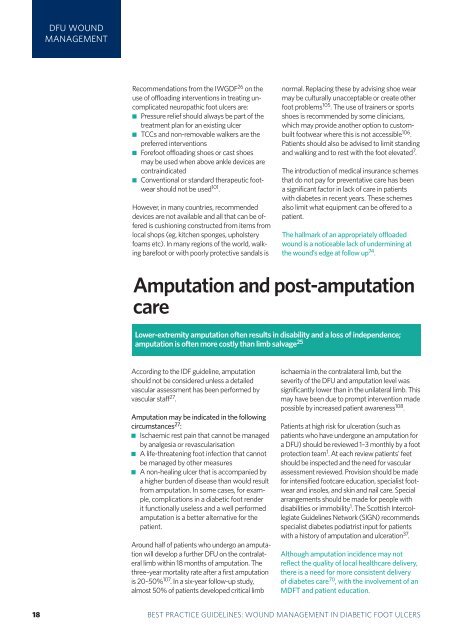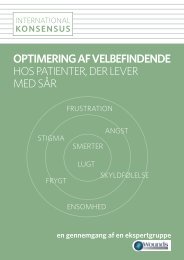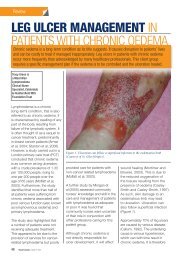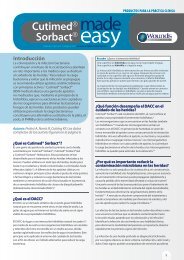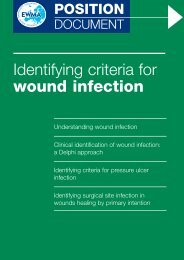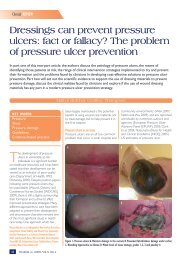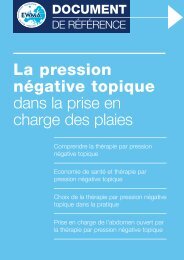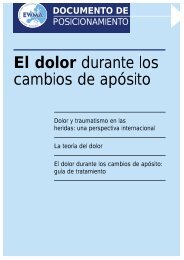DFU WOUNDMANAGEMENTRecommendations from the IWGDF 26 on theuse of offload<strong>in</strong>g <strong>in</strong>terventions <strong>in</strong> treat<strong>in</strong>g uncomplicatedneuropathic <strong>foot</strong> <strong>ulcers</strong> are: Pressure relief should always be part of thetreatment plan for an exist<strong>in</strong>g ulcer TCCs and non-removable walkers are thepreferred <strong>in</strong>terventions Fore<strong>foot</strong> offload<strong>in</strong>g shoes or cast shoesmay be used when above ankle devices arecontra<strong>in</strong>dicated Conventional or standard therapeutic <strong>foot</strong>wearshould not be used 101 .However, <strong>in</strong> many countries, recommendeddevices are not available and all that can be offeredis cushion<strong>in</strong>g constructed from items fromlocal shops (eg, kitchen sponges, upholsteryfoams etc). In many regions of the world, walk<strong>in</strong>gbare<strong>foot</strong> or with poorly protective sandals isnormal. Replac<strong>in</strong>g these by advis<strong>in</strong>g shoe wearmay be culturally unacceptable or create other<strong>foot</strong> problems 105 . The use of tra<strong>in</strong>ers or sportsshoes is recommended by some cl<strong>in</strong>icians,which may provide another option to custombuilt<strong>foot</strong>wear where this is not accessible 106 .Patients should also be advised to limit stand<strong>in</strong>gand walk<strong>in</strong>g and to rest with the <strong>foot</strong> elevated 7 .The <strong>in</strong>troduction of medical <strong>in</strong>surance schemesthat do not pay for preventative care has beena significant factor <strong>in</strong> lack of care <strong>in</strong> patientswith diabetes <strong>in</strong> recent years. These schemesalso limit what equipment can be offered to apatient.The hallmark of an appropriately offloaded<strong>wound</strong> is a noticeable lack of underm<strong>in</strong><strong>in</strong>g atthe <strong>wound</strong>’s edge at follow up 74 .Amputation and post-amputationcareLower-extremity amputation often results <strong>in</strong> disability and a loss of <strong>in</strong>dependence;amputation is often more costly than limb salvage 25Accord<strong>in</strong>g to the IDF guidel<strong>in</strong>e, amputationshould not be considered unless a detailedvascular assessment has been performed byvascular staff 27 .Amputation may be <strong>in</strong>dicated <strong>in</strong> the follow<strong>in</strong>gcircumstances 27 : Ischaemic rest pa<strong>in</strong> that cannot be managedby analgesia or revascularisation A life-threaten<strong>in</strong>g <strong>foot</strong> <strong>in</strong>fection that cannotbe managed by other measures A non-heal<strong>in</strong>g ulcer that is accompanied bya higher burden of disease than would resultfrom amputation. In some cases, for example,complications <strong>in</strong> a <strong>diabetic</strong> <strong>foot</strong> renderit functionally useless and a well performedamputation is a better alternative for thepatient.Around half of patients who undergo an amputationwill develop a further DFU on the contralaterallimb with<strong>in</strong> 18 months of amputation. Thethree–year mortality rate after a first amputationis 20–50% 107 . In a six-year follow-up study,almost 50% of patients developed critical limbischaemia <strong>in</strong> the contralateral limb, but theseverity of the DFU and amputation level wassignificantly lower than <strong>in</strong> the unilateral limb. Thismay have been due to prompt <strong>in</strong>tervention madepossible by <strong>in</strong>creased patient awareness 108 .Patients at high risk for ulceration (such aspatients who have undergone an amputation fora DFU) should be reviewed 1–3 monthly by a <strong>foot</strong>protection team 1 . At each review patients' feetshould be <strong>in</strong>spected and the need for vascularassessment reviewed. Provision should be madefor <strong>in</strong>tensified <strong>foot</strong>care education, specialist <strong>foot</strong>wearand <strong>in</strong>soles, and sk<strong>in</strong> and nail care. Specialarrangements should be made for people withdisabilities or immobility 1 . The Scottish IntercollegiateGuidel<strong>in</strong>es Network (SIGN) recommendsspecialist diabetes podiatrist <strong>in</strong>put for patientswith a history of amputation and ulceration 37 .Although amputation <strong>in</strong>cidence may notreflect the quality of local healthcare delivery,there is a need for more consistent deliveryof diabetes care 70 , with the <strong>in</strong>volvement of anMDFT and patient education.318 BEST PRACTICEBEST PRACTICEGUIDELINESGUIDELINES:FOR SKINWOUNDAND WOUNDMANAGEMENTCARE ININEPIDERMOLYSISDIABETIC FOOTBULLOSAULCERS
Integrated care approachINTEGRATEDCARE APPROACHDFUs are a multifaceted condition and no one <strong>in</strong>dividual or cl<strong>in</strong>ical specialty shouldbe expected (or should attempt) to address all aspects of <strong>management</strong> <strong>in</strong> isolationMULTIDISCIPLINARY FOOTCARETEAMEvidence consistently highlights the benefits ofMDFTs <strong>in</strong> the outcomes of DFUs. Over 11 years,one study found total amputations fell by 70%follow<strong>in</strong>g improvements <strong>in</strong> <strong>foot</strong>care services,<strong>in</strong>clud<strong>in</strong>g multidiscipl<strong>in</strong>ary team work 109 .However, <strong>in</strong> England around one-fifth ofhospitals provid<strong>in</strong>g <strong>in</strong>patient care for peoplewith diabetes have no MDFT 5 . Furthermore, <strong>in</strong>many areas of the country there are no clearpathways for referr<strong>in</strong>g patients at <strong>in</strong>creasedrisk or high risk of develop<strong>in</strong>g DFUs, as recommendedby NICE 5 .All the major <strong>guidel<strong>in</strong>es</strong> recommend thatpatients identified with new DFUs should bereferred to a dedicated MDFT 1,4,7,26,27,37,110 .There are many different considered op<strong>in</strong>ionsabout which discipl<strong>in</strong>es should be <strong>in</strong>corporated<strong>in</strong> an MDFT.The IDF recommends that a specialist <strong>foot</strong>careteam will <strong>in</strong>clude doctors with a special <strong>in</strong>terest<strong>in</strong> diabetes, people with educational skillsand people with formal tra<strong>in</strong><strong>in</strong>g <strong>in</strong> <strong>foot</strong> care(usually diabetes podiatrists and tra<strong>in</strong>ed nurses).For comprehensive care, this team wouldbe enhanced by vascular surgeons, orthopaedicsurgeons, <strong>in</strong>fection specialists, orthotists,social workers and psychologists (Box 6).Guidel<strong>in</strong>es aside, it will be local resources thatdictate the skill mix and scope of any <strong>foot</strong>careteam. In the UK there is a move towards hav<strong>in</strong>ga core team of specialist diabetes podiatrists,medical specialty consultants, orthotistsand surgeons, which works with additionalrelevant discipl<strong>in</strong>es (such as nurses and generalpractitioners) almost <strong>in</strong> a virtual manner.The key is the ability to ga<strong>in</strong> immediate accessto relevant healthcare professionals (such as avascular surgeon) as needed.In many countries it is not only specialistequipment that may be unavailable, but alsothe specialist practitioners themselves, suchas podiatrists, vascular surgeons or plastertechnicians and so on. While the MDFT willbe manag<strong>in</strong>g the ongo<strong>in</strong>g challenges of DFUcare, non-specialist practitioners can play akey role <strong>in</strong> the early detection of problemsand prompt referral to the team.PATIENT FOOTCARE EDUCATIONPatient education should be an <strong>in</strong>tegral partof <strong>management</strong> and prevention. Treatmentoutcomes will be directly <strong>in</strong>fluenced bypatients’ knowledge of their own medicalstatus, their ability to care for their <strong>wound</strong>and concordance with their treatment 13,38 .It is vital that patients should know who tocontact if a DFU develops or recurs, <strong>in</strong>clud<strong>in</strong>gemergency numbers for the MDFT and outof-hourscontact details 37 .The development of an ulcer is a major eventand a sign of progressive disease. It is importantto discuss the impact of the ulcer on lifeexpectancy with the patient. Education shouldbe offered on ways <strong>in</strong> which patients canhelp to improve outcomes by mak<strong>in</strong>g lifestylechanges (eg smok<strong>in</strong>g cessation) and work<strong>in</strong>gwith practitioners to reduce the risk of recurrenceand life-threaten<strong>in</strong>g complications 13 .A Cochrane systematic review found thateducat<strong>in</strong>g people with diabetes about theneed to look after their feet improves their<strong>foot</strong>care knowledge and behaviour <strong>in</strong> theshort term. There was <strong>in</strong>sufficient evidencethat education alone, without any additionalpreventive measures, effectively reduces theoccurrence of <strong>ulcers</strong> and amputations 111 .Accord<strong>in</strong>g to the IWGDF, patient educationshould be provided <strong>in</strong> several sessions us<strong>in</strong>ga variety of methods based on standardeffective communication techniques. It isessential to evaluate whether the patient hasunderstood the messages, is motivated to actand has sufficient self-care skills 7 . Rememberthat elderly and disabled patients may needhome or special care 45 .Practitioners should ensure patients understandthe aims of treatment, how to recogniseand report the signs and symptoms of(worsen<strong>in</strong>g) <strong>in</strong>fection and the need for prompttreatment of new <strong>wound</strong>s 7,17 .BOX 6: Recommended levelsof <strong>foot</strong> care <strong>in</strong> acute and communitysett<strong>in</strong>gs 71. General practitioner, diabetespodiatrist and <strong>diabetic</strong>nurse2. Diabetologist, surgeon(general and/or vascular,plastic and/or orthopaedic),<strong>in</strong>fectious dieases/microbiologyspecialist, diabetespodiatrist and <strong>diabetic</strong>nurse3. Specialised <strong>foot</strong> centre withmultiple discipl<strong>in</strong>es specialised<strong>in</strong> <strong>foot</strong> careBEST PRACTICE GUIDELINES: WOUND MANAGEMENT IN DIABETIC FOOT ULCERS 19


